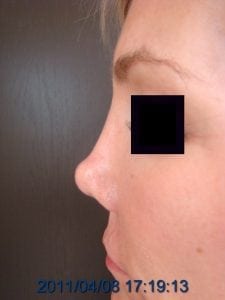Posted July 25, 2014 in Face, JUVÉDERM® and Restylane®
I am increasingly using injectable fillers to improve nasal defects that previously required surgery. Use of Juvederm and Restylane has proven valuable in specific types of deformities involving the nasal dorsum (bridge of the nose).
Typical nasal deformities addressed by hyaluronic acid fillers:
- Saddle nose. A saddle nose occurs when there is reduced support to the middle third of the central nose, causing it to become concave, instead of straight. (Hint: it looks similar to a horse saddle.) Injection of filler into the concavity can make the nose appear straighter on profile.
| Saddlenose correction | |
 |
 |
| Before | After |
- Contour irregularities of the nasal bridge caused by prior rhinoplasty (nasal reshaping) surgery. Rhinoplasty surgery sometimes leads to small defects, such as localized areas of flatness or concavity. Injection of facial fillers may correct these small irregularities.
| Contour irregularity on bridge of nose | |
 |
 |
| Before | After |
- Nasal deviation caused by prior rhinoplasty surgery. A mildly twisted nose either due to prior rhinoplasty or incompletely corrected by prior nasal surgery can be camouflaged by selective filler injections, making the nose appear straighter.
Keep in mind that Juvederm and Restylane typically last 6 to 12 months, so these are not permanent solutions. However, they can certainly be repeated—and there is generally enough left in the syringe to inject other areas of the face (lips, folds, lines).
While these techniques are not a substitute for secondary rhinoplasty in the case of a large nasal deformity, subtle defects are often more easily, cheaply, and reliably treated by hyaluronic acid injectibles, particularly in patients who are reluctant to undergo yet another rhinoplasty surgery.
Ronald M. Friedman, M.D.
Director, West Plano Plastic Surgery Center
Former Chief of Plastic Surgery, Parkland Memorial Hospital, Dallas